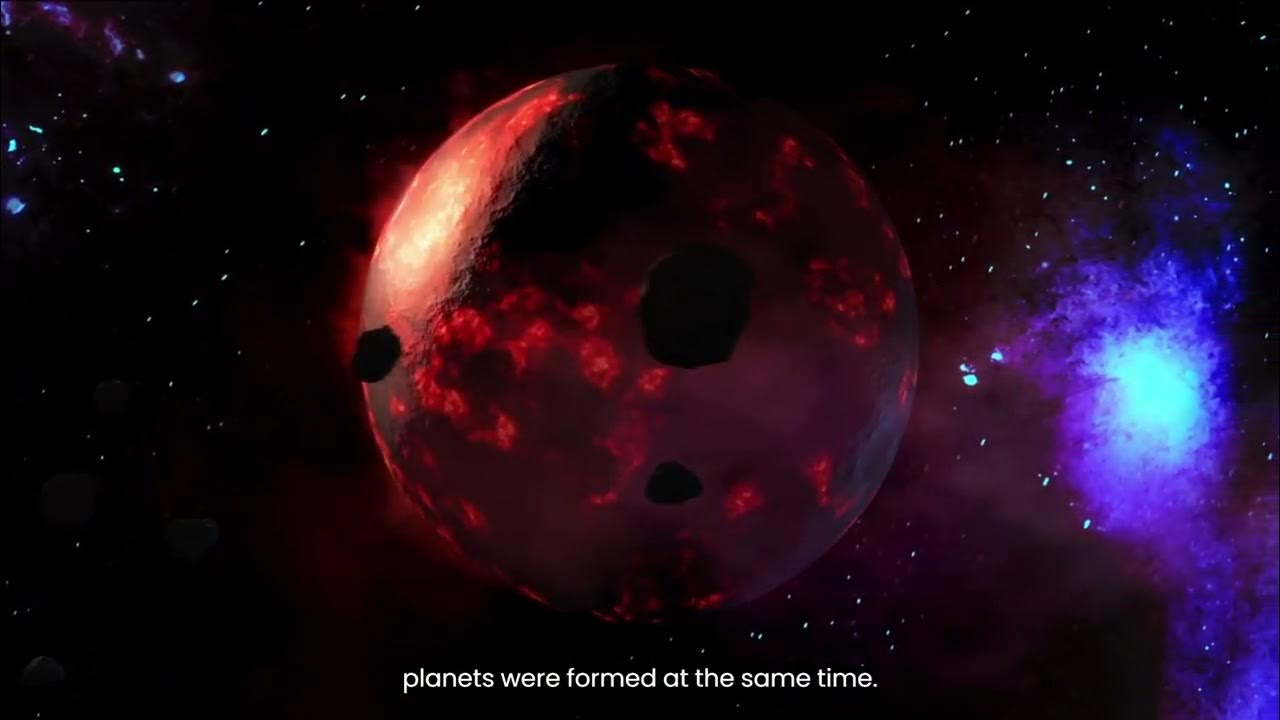Nebular Hypothesis - Origin of the Earth Solar system
Summary
TLDRThis video explores the early theories on Earth's origin, focusing on the Nebular Hypothesis proposed by Kant and revised by Laplace. It explains that the universe, including the Sun, planets, and stars, originated from a nebula cloud composed of hydrogen, helium, and dust. The Sun formed first through fusion reactions, while heavier elements like carbon and iron moved outward, forming planetesimals. These clumps of matter eventually accreted into planets, with Earth and others being denser than stars. The video invites viewers to subscribe for more educational content.
Takeaways
- 🌌 The early theory of Earth's origin is rooted in the Nebula Hypothesis, which suggests that the Sun, planets, stars, and asteroids were all created from a nebula cloud.
- 🌞 The Sun, being the largest star in our solar system, is believed to have formed first, with lighter elements like hydrogen and helium colliding and fusing to generate energy.
- 🔥 The process of fusion in the nebula cloud, due to friction and collision of particles, led to the creation of the Sun, marking the beginning of our solar system.
- 🌍 Planets, including Earth, are thought to have formed later than stars, from heavier elements that moved away from the center of the nebula cloud.
- 💨 The heavier elements formed clumps and, through further rotation and collision, led to the formation of a disc-shaped cloud, which eventually became planets.
- 📚 The Nebula Hypothesis was initially proposed by the German philosopher Emmanuel Kant and later revised by mathematician Laplace in 1796.
- 📈 The age of celestial bodies varies, with planets being around 4.5 billion years old and most stars ranging from 1 billion to 10 billion years old.
- 🌟 The Sun is considered the biggest star in the universe, a key point in understanding the formation of our solar system.
- ⚫ The lighter elements moved to the center to form the Sun, while heavier elements like carbon, oxygen, nitrogen, iron, phosphorus, and silicon formed the planets.
- 💥 The formation of planets involved the process of accretion, where heavy elements accumulated layer by layer to create the solid bodies we know today.
- 👀 The script encourages viewers to subscribe for more educational content and stay updated on the release of new videos.
Q & A
What is the main topic of the video?
-The main topic of the video is the early theories behind the origin of the Earth, focusing on the Nebular Hypothesis.
Who proposed the initial theory discussed in the video?
-The initial theory discussed in the video was proposed by the German philosopher Emmanuel Kant.
Who revised Kant's theory in 1796?
-The mathematician Pierre-Simon Laplace revised Kant's theory in 1796.
What is the Nebular Hypothesis?
-The Nebular Hypothesis is an early theory that suggests the solar system, including the Earth, was formed from a rotating cloud of gas and dust called a nebula.
What elements were present in the nebula according to the script?
-The nebula was made of helium, hydrogen, and other sorts of dust particles.
Why did the heavier elements move away from the center of the nebula?
-The heavier elements moved away from the center of the nebula because lighter elements like hydrogen and helium moved to the center, forming the Sun, due to the process of rotation and collision.
What process led to the formation of the Sun?
-The formation of the Sun was a result of fusion reactions that took place due to the friction and collision of hydrogen and helium particles at the center of the nebula.
How did the planets form according to the Nebular Hypothesis?
-The planets formed through the process of accretion, where heavier elements moved away from the center and clumped together to form smaller nebulas, which eventually formed disc-shaped clouds and then planets.
What is the estimated age of the Earth and the Sun?
-The Earth is estimated to be around 4.5 billion years old, while most stars, including the Sun, are between 1 billion to 10 billion years old.
What is the significance of the Sun being the biggest star in the universe according to the video?
-The video emphasizes the Sun being the biggest star in our universe to highlight its importance in the formation of the solar system and the process that led to the creation of the Earth and other planets.
What is the relationship between the age of stars and planets as mentioned in the script?
-The script mentions that stars were formed before planets, with planets being around 4.5 billion years old and most stars being older, ranging from 1 billion to 10 billion years old.
Outlines

此内容仅限付费用户访问。 请升级后访问。
立即升级Mindmap

此内容仅限付费用户访问。 请升级后访问。
立即升级Keywords

此内容仅限付费用户访问。 请升级后访问。
立即升级Highlights

此内容仅限付费用户访问。 请升级后访问。
立即升级Transcripts

此内容仅限付费用户访问。 请升级后访问。
立即升级5.0 / 5 (0 votes)






